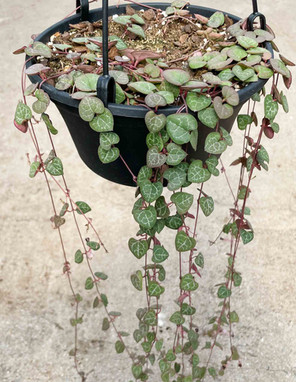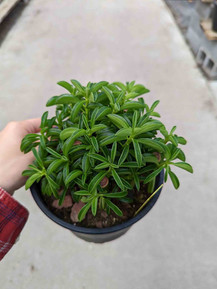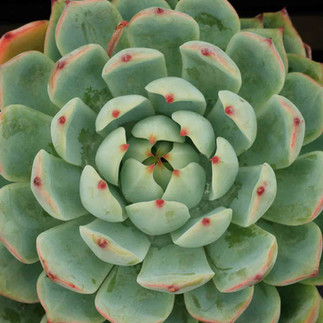1. LIPSTICK PLANT, AESCHAYNTHUS RADICANS
Lipstick Plant is a beautiful trailing foliage option that also sports showy blooms on occasion. We love the patterning on the leaves of the 'Zebra' cultivar especially! Grow in bright indirect light, and water only when almost dry (they don't like sitting wet). A warm, more humid environment helps stimulate blooming.
2. STAGHORN FERN, PLATYCERIUM BIFURCATUM
Getting its name from the fact that its fronds resemble that of a deer or elk, this pet-safe fern is popular mounted on wood and hung on the wall. In the wild, these plants are epiphytic, meaning they grow on the sides of trees - so mounting them with sphagnum moss and fishing line closely resembles their natural habitat. Staghorn Ferns like indirect/partial light and frequent watering (though allow them to dry out slightly in between). If you have a mounted fern, simply take it off the wall and soak it in your sink for 15-20 minutes until the roots are fully saturated.
This is just one of many members of the fern family that are pet safe, along with Bluestar Ferns, Pteris Brake Ferns, Crocodile Ferns, Rabbit's Foot Ferns, Bird's Nest Ferns, and Lemon Button Ferns.
3. STRING OF HEARTS & VARIEGATED STRING OF HEARTS, CEROPEGIA WOODII (VARIEGATA)
A highly requested plant, both the variegated and non-variegated variety of this trailing succulent are pet safe. As with most succulents, this plant prefers LOTS of bright, indirect light (too much direct sun will burn its leaves), and to dry out between watering. For best success with this plant, place it near a southern window, bottom water when the soil is almost/completely dry, and fertilize frequently with succulent-specific fertilizer when actively growing.

4. VENUS FLYTRAP, DIONAEA MUSCIPULA & CAPE SUNDEW, DROSERA CAPENSIS
Venus Flytraps and Sundews are always a fun option, especially for kids, so it's helpful that they are nontoxic to humans and pets. Indoors, they do best when grown in very bright light/direct sun, with a dish underneath the pot with water in it. They naturally live in bogs, so keeping the soil consistently moist is key - however, make sure to use rain water, spring water, or distilled water as chemicals or fertilizer can quickly kill them.
5. SPIDER PLANT, CLOROPHYTUM COMOSUM
Did you know that spider plants are available in straight, curly, variegated, and reverse-variegated varieties? These plants are great for beginners, easy to care for (though they do not like to be neglected), make a statement on a shelf or plant hanger, and are suitable for a wide range of growing conditions. While pet safe, cats love the long grass-like leaves on this plant, and it contains a chemical compound that is mildly hallucinogenic - meaning it may be your cat's new favorite plant... so keep it out of reach if you don't want it eaten!

6. BIRD'S NEST FERN
We've had several varieties of this low light loving, pet safe fern over the years at Painters. With a fun growing habit, bright green fronds, and varying shapes and sizes, this plant compliments any houseplant collection and is guaranteed to keep your pets safe. As with most ferns, Bird's Nest Ferns love lower light, frequent waterings (do not let it dry out too much), and high humidity.
As of March 2023, we have Japanese Bird's Nest Ferns (top and far right photo) available at Painters Greenhouse. This variety was selected for how well it does in normal household humidity (yay fewer brown tips)!

7. CALATHEA 'RATTLESNAKE PLANT', GOEPPERTIA INSIGNIS
Rattlesnake Plants are just one of many pet-safe varieties of Goeppertia (formerly Calathea), and they all feature stunning leaves that look as though they've been hand-painted. Goeppertia can get a bad rap for being high maintenance, but some such as Goeppertia Rattlesnake, Orbifolia, and Peacock make for moderately easy houseplants with a big impact! These plants like high humidity, thrive in medium, indirect light, and don't like to dry out too much in between waterings.
In order: Calathea ‘Zebra Plant’, Goeppertia zebrina; Calathea Orbifolia, Goeppertia orbifolia, Calathea ‘Jungle Velvet’, Goeppertia warszewiczii tigrina, Calathea Fishbone Prayer Plant, Ctenanthe burle-marxii ‘amagris’; Calathea Peacock Plant, Goeppertia makayona; Calathea Pinstripe Plant, Goeppertia ornata.

8. BURRO'S TAIL, SEDUM MORGANANIUM
Burro's Tail (Sedum morgananium) is nontoxic, as are most other sedum. This trailing plant does best in baskets as it tends to get heavy when the stems get long. We love the unique appearance, and it's very easy care, liking bright light and low water. While it isn't toxic, we recommend hanging out of reach, as all it takes is one smack from a frisky paw to knock some of the delicate leaves off!

9. PEPEROMIA 'CUPID', PEPEROMIA SCANDENS
Peperomia 'Cupid' is a great option for those looking for a trailing plant. All peperomia are low-maintenance, pet-safe houseplants that make a statement on their own, or great accent plants. They maintain a smaller form, never growing beyond 12”-18". Peperomia are a member of the pepper family, but not the one that gives us green or hot peppers; they come from the pepper family that gives us the pepper spice! They include a variety of colors - purples, red, greens, grays, and creams, and can have plump succulent-like leaves, thinner rippled leaves, or long, narrow, pointy leaves (just to name a few). There are so many varieties to choose from!
Assorted pet-safe Peperomia.

10. CAST IRON PLANT
A member of the lily family with eye-catching leaves speckled in white, this pet friendly plant adapts well to the home, is extremely easy to care for, and will even tolerate some neglect. (While pet safe, cats love this plant, so you may want to keep it out of reach to prevent it from being munched on!)
11. ECHEVERIA
With endless colors and patterns to choose from, pet-safe Echeveria gives you so many options! Don't be afraid of it because it's a succulent - as long as you have bright light and water infrequently (from underneath is ideal), you can keep these happy for a long time. If it gets too tall, cut the top off and watch it regrow.

12. NERVE PLANT, FITTONIA
This plant is adorned with lovely accented veins on the leaves which lead to its name. Relatively easy care, nerve plant does appreciate regular watering, or it will droop/wilt dramatically (watering quickly perks it back up). They prefer medium light and higher humidity, doing great in terrariums.

13. NEANTHE BELLA PARLOUR PALM, CHAMAEDROREA ELEGANS
Palms are one of the best options for someone looking for a large statement plant that is pet safe, and we especially love this one. Palms add a tropical flare and tend to be easy care - the Neanthe Bella can handle medium to lower light, and prefers to be allowed to slightly dry between waterings (water when top 2 inches of soil are dry). With ficus, corn plants and so many other large houspelants being toxic if ingested, large palms are one of the best alternatives.
14. AIR PLANTS
Air plants are a stunning and unique pet safe addition to any house plant collection. They don't need to be potted in soil, and there are many creative ways to display them. To care for your air plant, provide it with bright indirect light, completely submerge it in water for 20 minutes every 1-2 weeks, and dry upside down. Want to get creative? Add an air plant to a terrarium, tuck them into a seashell or beautiful piece of driftwood, hang them with fishing line, or use a macrame air plant hanger!
15. STRING OF TURTLES
A member of the Peperomia family, String of Turtles and all Peperomia make great pet safe houseplants! Typically they prefer lots of bright, indirect light and to dry out completely between waterings. The more light they get, the more you can enjoy the dramatic venation!

16. HOYA MACROPHYLLA
This low-maintenance vining Hoya, aka wax plant, is one of many varieties of Hoya that are pet safe. Hoya all love to climb, have thick waxy leaves, and if given the right care and a little luck produce beautiful flowers. Hoyas make great additions to plant hangers and also look great trellised. Hoyas need less frequent watering than other vining houseplants, like bright indirect light, and you can give them a boost by spritzing with orchid fertilizer 1-2 times a month.
In order: Hoya 'Krohniana Black', Hoya 'Krimson Queen', Hoya publicalyx, Hoya publicalyx 'splash', and Hoya macrophylla.
.png)








































































































Comments